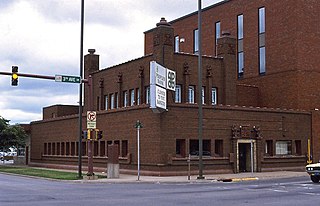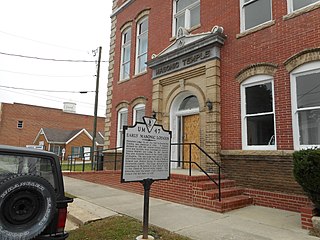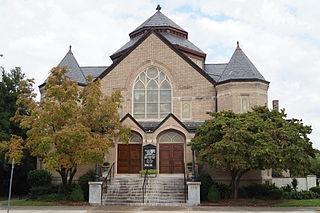
The National Farmers' Bank of Owatonna, Minnesota, United States, is a historic bank building designed by Louis Sullivan, with decorative elements by George Elmslie. It was built in 1908, and was the first of Sullivan's "jewel box" bank designs. The building is clad in red brick with green terra cotta bands, and features two large arches on its street-facing facades. Single-story wings, originally housing bank offices, extend along each side. Internal elements include two stained-glass windows designed by Louis J. Millet, a mural by Oskar Gross, and four immense cast iron electroliers designed by Elmslie and cast by Winslow Brothers Company.

The Peoples Savings Bank in Cedar Rapids, Iowa, was designed by Louis Sullivan. It was the second of a number of small "jewel box" banks in midwest towns designed by Sullivan during 1907 to 1919. It was built in 1911, and it was individually listed on the National Register of Historic Places in 1978. In 2014 it was included as a contributing property in the West Side Third Avenue SW Commercial Historic District.

The Merchants' National Bank (1914) building is a historic commercial building located in Grinnell, Iowa. It is one of a series of small banks designed by Louis Sullivan in the Midwest between 1909 and 1919. All of the banks are built of brick and for this structure he employed various shades of brick, ranging in color from blue-black to golden brown, giving it an overall reddish brown appearance. It was declared a National Historic Landmark in 1976 for its architecture. In 1991 it was listed as a contributing property in the Grinnell Historic Commercial District.
Farmers and Merchants Bank may refer to:

The People's Federal Savings and Loan Association is a historic bank building at 101 East Court Street in Sidney, Ohio, designed by Chicago architect Louis Sullivan. It was designed and built in 1917 for use by Peoples Federal Savings and Loan Association, which still operates out of it. It is one of a handful of banks designed by Sullivan between 1908 and 1919 for small communities in the central United States. The building is a National Historic Landmark.

The Farmers and Merchants Union Bank is a historic commercial building at 159 West James Street in Columbus, Wisconsin. Built in 1919, it is the last of eight "jewel box" bank buildings designed by Louis Sullivan, and the next to last to be constructed. It was declared a National Historic Landmark in 1976 for its architecture.

The Barnes and Thornburg Building is a high rise in Indianapolis, Indiana originally known as the Merchants National Bank Building. In 1905, the Merchants National Bank and Trust Company engaged the architectural firm of D. H. Burnham & Company of Chicago to design a new bank headquarters on the southeastern corner of the Washington and Meridian streets, the most important intersection in Indianapolis. Initial occupancy of the lower floors took place in 1908, while the upper floors were not completed until 1912.

Farmers and Merchants Bank, also known as Geneva Savings Bank, is a historic bank building located at Geneva in Ontario County, New York. It was constructed in 1914–1915 and is a 2+1⁄2-story, three-bay brick building with a cast stone facade. The facade embodies a full range of Neoclassical features derived from ancient Greek architecture that were meant to convey a sense of integrity, durability, and reliability to the venerable financial institution of public banking.

The Farmers and Merchants Bank-Masonic Lodge a is historic commercial and fraternal building at 288 North Broadway in Booneville, Arkansas. It is a two-story structure, with Colonial Revival and Early Commercial architecture. It was listed on the National Register of Historic Places in 1993.

Davenport Bank and Trust Company was for much of the 20th century the leading bank of the Quad Cities metropolitan area and the surrounding region of eastern Iowa and western Illinois. It was at one time Iowa's largest commercial bank, and the headquarters building has dominated the city's skyline since it was constructed in 1927 at the corner of Third and Main Streets in downtown Davenport, Iowa. It was acquired by Norwest Bank of Minneapolis in 1993 and now operates as part of Wells Fargo following a 1998 merger of the two financial institutions. The historic building was listed on the National Register of Historic Places in 1983 under the name of its predecessor financial institution American Commercial and Savings Bank. In 2016 the National Register approved a boundary increase with the Davenport Bank and Trust name. It was included as a contributing property in the Davenport Downtown Commercial Historic District in 2020. It remains the tallest building in the Quad Cities, and is today known as Davenport Bank Apartments as it has been redeveloped into a mixed-use facility housing commercial, office, and residential space.

The Farmers and Merchants Bank, now the Nampa Public Library, at 101 11th Ave., S., in Nampa, Idaho is an Idaho bank building whose construction began in 1919. It was designed by Idaho's most notable architects Tourtellotte & Hummel in Classical Revival style that suggests solidity. It is a 60 feet (18 m) by 90 feet (27 m) two-story building with a portico consisting of a pediment supported by two pairs of Ionic columns. The pediment's tympanum contains an eagle sculpture. Within the portico, above the front door of the bank, is "Nampa Public Library" in block letters and a smaller pediment is sculpted and includes insignia of the First National Bank.

The Old Merchants and Farmers Bank Building, also known as the Old Public Library, is a historic bank building located at Emporia, Virginia. It was built in 1902, and is a one-story, eclectic, red and yellow brick structure with a concave mansard roof. The front facade features a galvanized sheet-metal cornice that may have been manufactured by H. T. Klugel. The bank occupied the building until 1914, after which it housed the public library until 1977. It is currently occupied by the Greensville-Emporia Historical Museum.

Hicksford–Emporia Historic District, also known as Emporia, is a national historic district located at Emporia, Virginia. The district includes 36 contributing buildings and 2 contributing objects in the Hicksford section of Emporia. In 1848, Hicksford was a stop on the Petersburg Railroad. In 1887, the neighboring towns of Hicksford and Belfield merged to form the town of Emporia. The district generally consists of late 19th century or early 20th century, when Hicksford–Emporia began to evolve from a small agricultural outpost to a large commercial and governmental center. Located at the heart of the district is the separately listed Greensville County Courthouse Complex. Other notable buildings include the Citizen's National Bank, the Widow's Son's Masonic Lodge (1905), First Presbyterian Church (1907-1908), Emporia Elementary School, Emporia Armory (mid-1930s), Greensville County Auditorium (1934), and Emporia Post Office (1938). The Old Merchants and Farmers Bank Building is also separately listed.
The Dumas Commercial Historic District encompasses the historic commercial heart of the rural community of Dumas, Arkansas, in the Mississippi River delta region of southeastern Arkansas. The town of Dumas was established in 1904, after the St. Louis, Iron Mountain and Southern Railway was built through the farm of William Dumas. The town's oldest surviving commercial building, the Porter Grocery, was one of several built by David Porter between 1905 and 1938. The historic district includes eight noteworthy buildings, including the Merchants & Farmers Bank building, a Colonial Revival National Register-listed building designed by Charles L. Thompson. All of the buildings occupy a single city block of South Main Street, between Choctaw and Waterman Streets. Most of the buildings of interest were built in the 1920s, and are vernacular brick commercial buildings.
The Merchants & Farmers Bank is a historic bank building at Waterman and Main Streets in Dumas, Arkansas. The Classical Revival brick building was built in 1913 to a design by Charles L. Thompson. It is a single story, with the brick laid in Flemish bond. The main entrance is flanked by marble Ionic columns.

Queen–Gordon Streets Historic District is a national historic district located at Kinston, Lenoir County, North Carolina. It encompasses 20 contributing buildings in a mixed commercial and industrial section of Kinston. The buildings include notable examples of Classical Revival, Beaux-Arts, and Romanesque style architecture and date between 1895 and the mid-1930s. Notable buildings include the Gordon Street Christian Church (1912-1915), (former) U. S. Post Office/Federal Building (1915), Citizens / First National Bank Building (1903), (former) Farmers and Merchants Bank (1924), Canady Building (1899), and the LaRoque and Hewitt Building.

Boonville Public Square Historic District is a national historic district located at Boonville, Warrick County, Indiana. It encompasses 50 contributing buildings in the central business district of Boonville. It developed between about 1855 and 1934, and includes representative examples of Italianate, Beaux-Arts, Queen Anne, Tudor Revival, and Art Deco style architecture. Located in the district is the separately listed Old Warrick County Jail. Other notable buildings include the Warrick County Courthouse (1904), Boonville Standard (Mellen) Building (1902), I.O.O.F. Building (1896), Peoples' Bank (1939), Carnegie Library (1918), Trimble Block (1903), and Farmers & Merchants Bank (1902).

Farmers and Merchants Bank Building, also known as The Wedge, is a historic bank building located at Monroe City, Monroe County, Missouri. It was erected in 1917, and is a wedge-shaped, flatiron building clad in tapestry brick. It features an impressive canted entrance covered in glazed terra cotta tile with a granite base.
Merchants Bank Building may refer to:
















